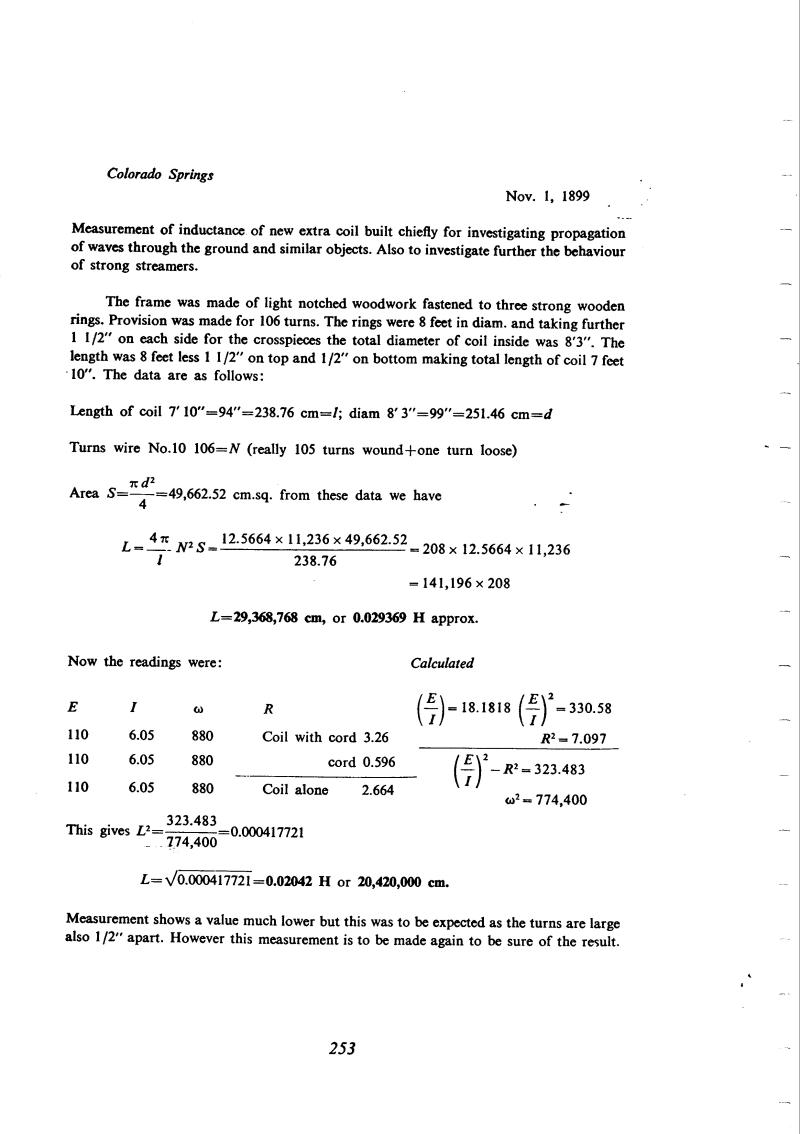
Nikola Tesla Books
Colorado Springs
Nov. 1, 1899
Measurement of inductance of new extra coil built chiefly for investigating propagation of waves through the ground and similar objects. Also to investigate further the behaviour of strong streamers.
The frame was made of light notched woodwork fastened to three strong wooden rings. Provision was made for 106 turns. The rings were 8 feet in diam. and taking further 1 1/2" on each side for the crosspieces the total diameter of coil inside was 8' 3". The length was 8 feet less 1 1/2" on top and 1/2" on bottom making total length of coil 7 feet 10". The data are as follows:
Length of coil 7' 10" = 94" = 238.76 cm = l; diam 8' 3" = 99" = 251.46 cm = d
Turns wire No. 10 106 = N (really 105 turns wound + one turn loose)
Area S = $! {\pi d^{2} \over 4} $! = 49,662.52 cm.sq. from these data we have
L = $! {4 \pi \over l} $! N2 S = $! {{12.5664 \times 11,236 \times 49,662.52} \over 238.76} $! = 208 x 12.5664 x 11,236
= 141,196 x 208
L = 29,368,768 cm, or 0.029369 H approx.
Now the readings were:
| E | I | Ï | R |
|---|---|---|---|
| 110 | 6.05 | 880 | Coil with cord 3.26 |
| 110 | 6.05 | 880 | cord 0.596 |
| 110 | 6.05 | 880 | Coil alone 2.664 |
Calculated
| $! {{\left({E \over I}\right)}} $! = 18.1818 $! {\left({E \over I}\right)^{2}} $! = 330.58 |
| R2 = 7.097 |
|
|
| $! {\left({E \over I}\right)^{2} - R^{2}} $! = 323.483 |
| Ï2 = 774,400 |
This gives L2 = $! {323.483 \over 774,400} $! = 0.000417721
L = $! {\sqrt{0.000417721}} $! = 0.02042 H or 20,420,000 cm.
Measurement shows a value much lower but this was to be expected as the turns are large also 1/2" apart. However this measurement is to be made again to be sure of the result.
253
November 1-2
The new extra coil was larger in diameter but shorter than the previous one (see August 23rd). The formula for an infinite coil introduces a rather large error, but with the correction referred to in the commentary to 26 October the agreement with the experimental results is good. The correction terms are significant because the ratio D/l is even greater than unity, and the correction is more than 30%. The corrected value is 0.0198 H, 2 - 3% less than the measured values.
November 1-2
The new "additional coil" is of larger diameter but of smaller length than the previous one (please see August 23). He performed the calculation again by following the equation for an infinite coil. When he compared these results with the measured value, he experienced a large mismatch. He suspected that the reason was the windings which were big and far apart. On November 2 he repeated the measurements but the measured value was similar. He draws the conclusion that the applied equation is not correct in this case and it will be less and less applicable as turns are at greater distance from each other. He considers that in the case where turns are very much separated, it is better to calculate the inductance of each turn separately and to multiply this value with the number of turns. If all of them are not the same (he probably thinks; if the distance is not always the same as is frequently the case with his coils), then he suggests that somehow the mutual inductance has to be incorporated.
When he performs the calculation of the coil with the correction we were talking about in the comment of Oct. 26, he obtains a good match with the experimental results. The correction figures are very significant, because the ratio D/l is even larger than l, so the equation for an infinite coil gives a value more than 30% larger than the corrected one.
The corrected calculated value in the case of Tesla's "additional coil" amounts to 0.0198H; which is 2% or 3% less than the two given measured values.

